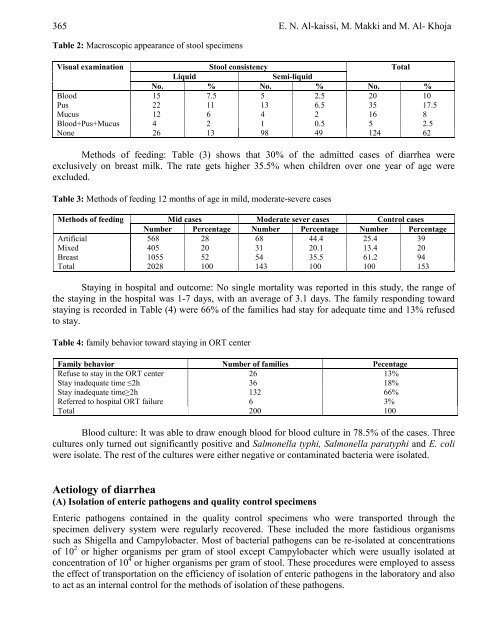European Journal of Scientific Research - EuroJournals
European Journal of Scientific Research - EuroJournals
European Journal of Scientific Research - EuroJournals
Create successful ePaper yourself
Turn your PDF publications into a flip-book with our unique Google optimized e-Paper software.
365 E. N. Al-kaissi, M. Makki and M. Al- Khoja<br />
Table 2: Macroscopic appearance <strong>of</strong> stool specimens<br />
Visual examination<br />
Stool consistency<br />
Total<br />
Liquid Semi-liquid<br />
No. % No. % No. %<br />
Blood 15 7.5 5 2.5 20 10<br />
Pus 22 11 13 6.5 35 17.5<br />
Mucus 12 6 4 2 16 8<br />
Blood+Pus+Mucus 4 2 1 0.5 5 2.5<br />
None 26 13 98 49 124 62<br />
Methods <strong>of</strong> feeding: Table (3) shows that 30% <strong>of</strong> the admitted cases <strong>of</strong> diarrhea were<br />
exclusively on breast milk. The rate gets higher 35.5% when children over one year <strong>of</strong> age were<br />
excluded.<br />
Table 3: Methods <strong>of</strong> feeding 12 months <strong>of</strong> age in mild, moderate-severe cases<br />
Methods <strong>of</strong> feeding<br />
Mid cases Moderate sever cases Control cases<br />
Number Percentage Number Percentage Number Percentage<br />
Artificial 568 28 68 44.4 25.4 39<br />
Mixed 405 20 31 20.1 13.4 20<br />
Breast 1055 52 54 35.5 61.2 94<br />
Total 2028 100 143 100 100 153<br />
Staying in hospital and outcome: No single mortality was reported in this study, the range <strong>of</strong><br />
the staying in the hospital was 1-7 days, with an average <strong>of</strong> 3.1 days. The family responding toward<br />
staying is recorded in Table (4) were 66% <strong>of</strong> the families had stay for adequate time and 13% refused<br />
to stay.<br />
Table 4: family behavior toward staying in ORT center<br />
Family behavior Number <strong>of</strong> families Pecentage<br />
Refuse to stay in the ORT center 26 13%<br />
Stay inadequate time ≤2h 36 18%<br />
Stay inadequate time≥2h 132 66%<br />
Referred to hospital ORT failure 6 3%<br />
Total 200 100<br />
Blood culture: It was able to draw enough blood for blood culture in 78.5% <strong>of</strong> the cases. Three<br />
cultures only turned out significantly positive and Salmonella typhi, Salmonella paratyphi and E. coli<br />
were isolate. The rest <strong>of</strong> the cultures were either negative or contaminated bacteria were isolated.<br />
Aetiology <strong>of</strong> diarrhea<br />
(A) Isolation <strong>of</strong> enteric pathogens and quality control specimens<br />
Enteric pathogens contained in the quality control specimens who were transported through the<br />
specimen delivery system were regularly recovered. These included the more fastidious organisms<br />
such as Shigella and Campylobacter. Most <strong>of</strong> bacterial pathogens can be re-isolated at concentrations<br />
<strong>of</strong> 10 2 or higher organisms per gram <strong>of</strong> stool except Campylobacter which were usually isolated at<br />
concentration <strong>of</strong> 10 4 or higher organisms per gram <strong>of</strong> stool. These procedures were employed to assess<br />
the effect <strong>of</strong> transportation on the efficiency <strong>of</strong> isolation <strong>of</strong> enteric pathogens in the laboratory and also<br />
to act as an internal control for the methods <strong>of</strong> isolation <strong>of</strong> these pathogens.

















